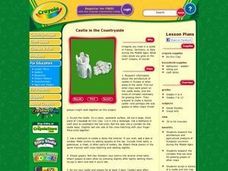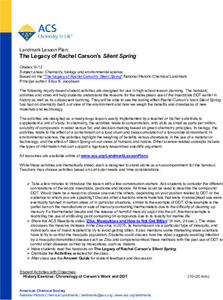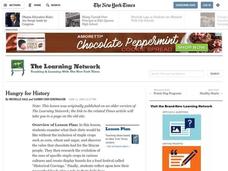Virginia Department of Education
DNA Extraction from Strawberries
Has your class ever been astounded by the complexity of DNA analysis? Have they ever asked why genetic engineering has become so important to our daily lives? Young scientists perform DNA extraction on strawberries and explore how the...
Curated OER
Pizza Farm Activities
Students identify the food groups and agricultural sources of pizza ingredients. They construct a construction paper pizza, identify the crops grown for pizza ingredients, and make and eat English muffin pizzas.
Curated OER
Changing Planet: Withering Plants - Stressing Over Lost Water
Expectant earth scientists examine the bottom side of a leaf and learn the role of the stomata. They consider the gas exchange that occurs through these structures and relate how the climate is changing to its impact on food crops. This...
Curated OER
Design a Colonial Garden
Students explore botany by completing an art design activity in class. In this gardening history instructional activity, students identify the plants and crops utilized in the Colonial era for both food and medicine. Students utilize...
Curated OER
Genetic Engineering of Crop Plants
Students explore genetic engineering and it biological and ethical implications. By conducting experiments with genetically engineered corn and plain corn they determine the difference in taste. Students also discover the effects of...
Curated OER
Recombinant DNA to Protect Crops
Students are asked to recount their greatest hopes and fears concerning DNA. One article states how worthwhile gene manipulation in plants can be. Classroom discussions arise after reading one article on this issue.
Curated OER
Corn-Crop is a Bin-Buster
Learners calculate percent change and create lists of data. They enter the corresponding bushels of corn measured in billions to their list and display, then convert the acres into scientific notation and use the value on the home screen...
Curated OER
Castle in the Countryside
Students research the architecture and agricultural products of European countries during the Middle Ages. Then they research the climates that are best for growing grapes or other crops. Students also sculpt a replica of a castle and...
Teach With Movies
Title: "The Yearling" - Topics: Literature/U.S.; U.S./1865-1913 & Florida
Life in the Florida swamps after the Civil War comes alive in the 1946 film adaptation of Majorie Kinnan Rawlings’s The Yearling. The film of this powerful coming-of-age story, filled with love and loss, can be used with or without a...
Chicago Botanic Garden
Introducing Ecosystem Services
Purifying air and water, providing soil in which to grow crops, and moving water through its natural cycle are all services an ecosystem provides that benefit humans. Lesson four in a series lets learners explore and discuss the value of...
Teaching Tolerance
Using Photographs to Teach Social Justice | Confronting Unjust Laws
The right to peacefully assembly to protest injustice is a key element of the First Amendment to the United States Constitution. Class members are asked to analyze two photographs of people confronting what they consider to be unjust...
American Chemical Society
The Legacy of Rachel Carson’s Silent Spring
How do we protect crops and protect the environment at the same time? Using reading materials, learners explore the history of the use of pesticides and biocides. They create a timeline and then explore the current practices.
Center for History Education
Transforming the West: Did the Reality Match the Expectations for Kansas Homesteaders?
They expected good soil and hearty crops ... but they found buffalo chips and grasshopper plagues. Using an advertisement encouraging famers to go west, budding historians examine primary sources including letters, photographs, and...
Curated OER
Edible GMOs?
The debate over genetically modified organisms is on! Young biologists imagine that they have been asked to choose which corn chips will be sold for a fundraiser, one made with GMOs or one without. This four-day lesson plan requires...
Curated OER
Clothes on the Grow
Can you grow clothes? Sure, wool, cotton, and Angora are all natural resources used to make textile products. Learners investigate the differences between synthetic and natural fibers, then consider textile processing careers. They watch...
Curated OER
Math: Real Time and Live
Get an interdisciplinary edge. Scholars study air contamination and slope. They record the time it takes for air fresheners to reach them at variable distances. They document their times, classify them by distance, and draw a scatter...
Curated OER
Next Year's Seeds
Reading, a math game, and a simulation activity provide the engagement on a lesson about seeds and crops. Learners in grades two through four read an informational passage about crops, seeds, and farming. They highlight important...
Curated OER
The True Cost of Coffee
Students examine the economic, health, and environmental risks of a one-crop economy in the developing world. They explain how or why it can be challenging for people of one culture to understand the lifestyle of a different society.
Curated OER
The Disappearing Honeybees: Tracking Honeybee Decline
Middle schoolers practice graphing and other math skills to track number of honeybee colonies present in United States since 1978, discuss major crops that are dependent on insect pollinators, and examine reasons for decline of United...
Curated OER
Fifth Grade Photoshop: Change That Background
Students explore the Photoshop program. In this technology lesson, students use cropping tools to crop photos out of the background on a Photoshop file. Students edit and paste a picture onto a new background.
Curated OER
Hungry for History
Students examine what their diets would be like without the inclusion of staple crops such as corn, wheat and sugar, and discover the value that chocolate had for the Mayan people. They create display boards for a food festival.
Curated OER
Altered Genes
Students describe the economic relationship between farmers, consumers, and food companies. They examine the issues regarding the reactions of consumers in this country and other countries to the use of gene-altered crops in food...
Curated OER
Hot Weather, Rain Mean Fewer Pumpkins
Students share their knowledge of pumpkins, then read a news article about how hot weather and rain are affecting the pumpkin crop. In this agriculture and current events lesson, the teacher introduces the article with a discussion and...
Curated OER
Arthur Young and the President
Young scholars work with NASS data by converting it into prose. In this historical agriculture information instructional activity, students read about how George Washington communicated information about crop yields, livestock, and land...
Other popular searches
- Climate and Crops
- Cash Crops
- Crops Grown in Illinois
- Florida Crops
- Biotechnology Crops
- Crops North America
- Food Crops
- Cotton Crops
- Cereal Crops
- Farm Crops
- Lebanon Crops
- Farms + Crops

























